Search Posts
Recent Posts
- Outdoors in RI: Help keep recreation areas clean. Invasive Milfoil, trash. 2A update – Jeff Gross July 26, 2024
- Real Estate in RI: Highest-ever sale in Queen’s Grant, EG $1.25M, by Residential Properties July 26, 2024
- Homeless in RI: Gov. Newsom issues Executive Order. Remove California’s encampments. July 26, 2024
- Let the games begin. XXXIII Summer Olympics – John Cardullo July 26, 2024
- GriefSPEAK: What would you do? – Mari Dias Nardolillo July 26, 2024
Categories
Subscribe!
Thanks for subscribing! Please check your email for further instructions.
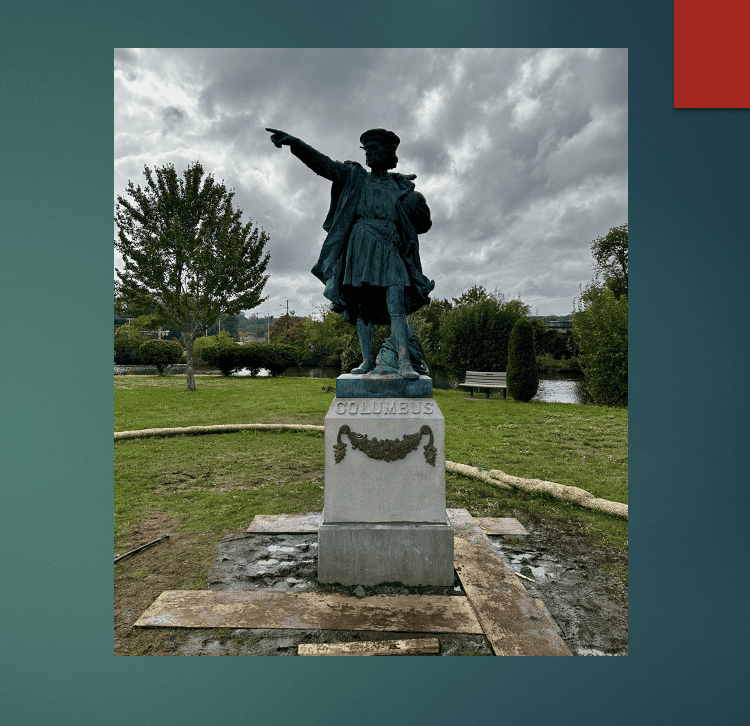
Johnston’s War Memorial Park opens its arms to an exiled Columbus
Yesterday, the controversial statue of Christopher Columbus found its final resting spot at the Johnston War Memorial Park, a park that has more war memorials than any other park in the state. It was moved into position in the early morning, from a storage facility at Johnston DPW.
There ends the journey for Columbus, who was summarily removed from his Providence platform during the time Black Lives Matter and other civil unrest demonstrations were at their height in the city a few years ago. Two or three acts of vandalism, primarily the throwing of red paint onto the statue, with threats of more serious acts, had the goal of getting the powers that be to remove the statue. And they did.
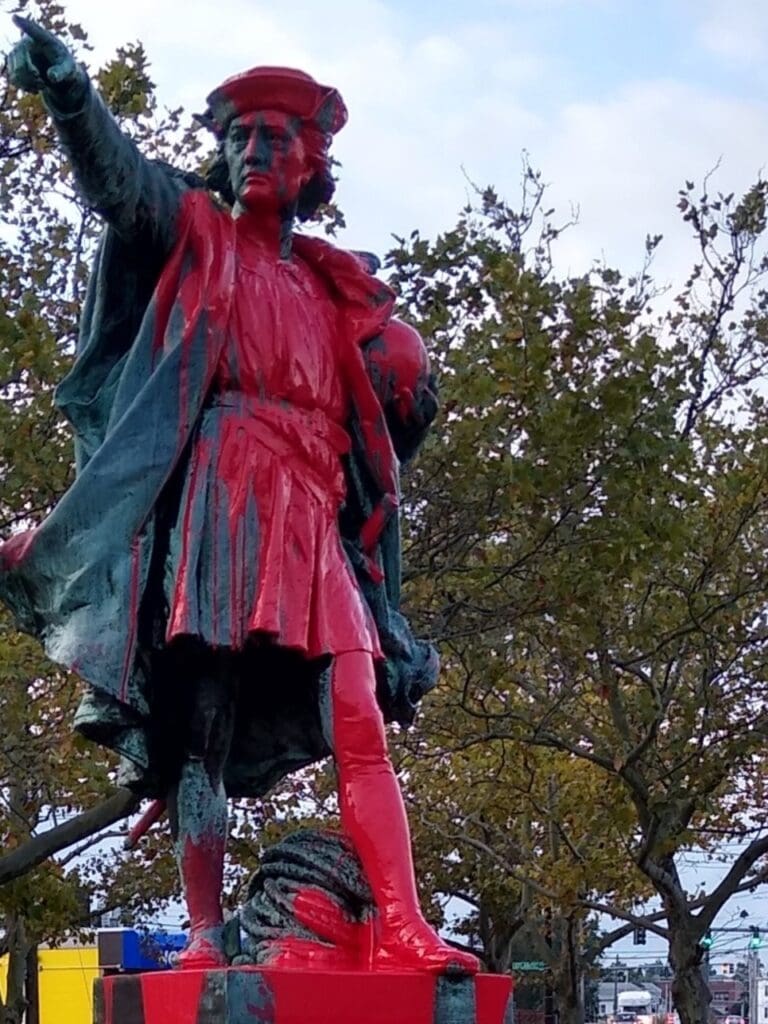
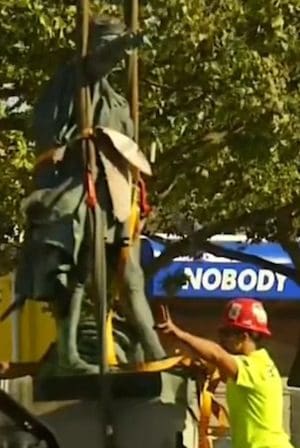
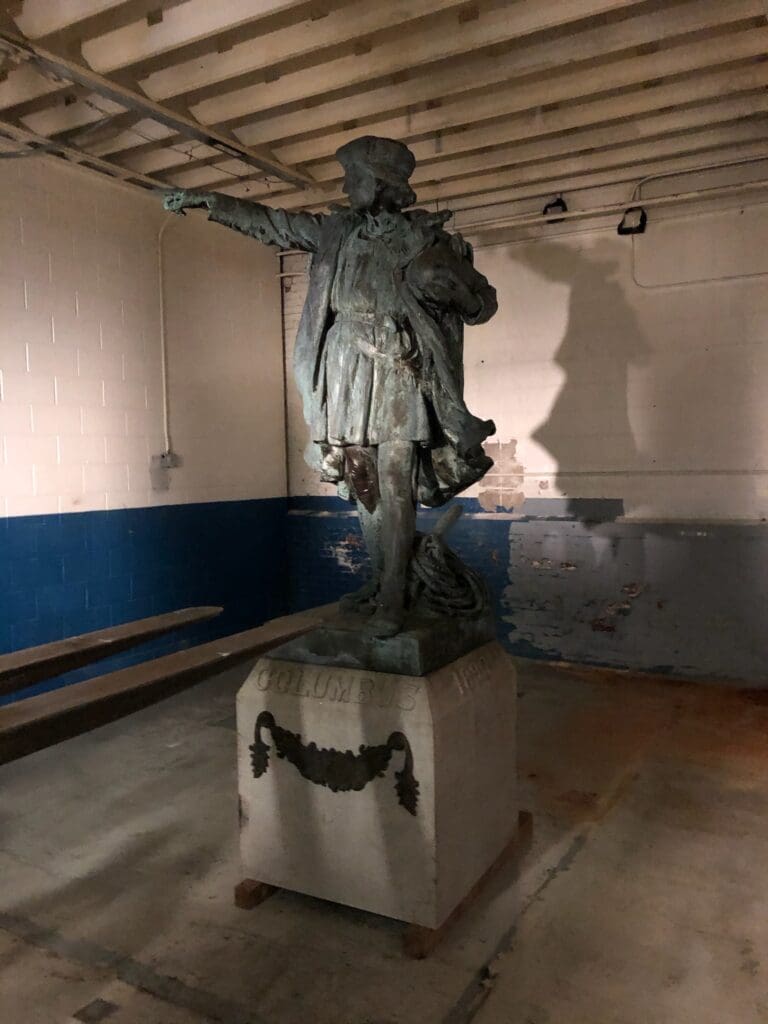
He was hoisted up and away, to sit in a warehouse, yards away, in irony, from where the annual Columbus Day Parade was held on Federal Hill. Then its future was put into the hands of a Providence committee which decided to sell it to the highest bidder with specific conditions that it not be melted down, resold, etc., and it had to have security. One bidder, a private individual in the southern part of the state stepped forward, but had no security plan.
Enter former Providence Mayor Joe Paolino Jr. who paid $50,000 for the statue and began looking for a place to locate it – and donate it. Enter Johnston Mayor Joe Polisena Jr, who readily agreed to take the statue into the city’s war memorial park – following through on a promise of his father, Mayor Joe Polisena. The tiny “island” of land with bridge access, benches all around, and a steady stream of walkers all times of day and evening, seemed like it was waiting all this time for its centerpiece.
Yesterday, he arrived. Now dark with green patina, the sculpture done by Frédéric Auguste Bartholdi, who also created the Statue of Liberty, was gifted to the city of Providence in 1893. It was never officially appraised but is estimated to be easily worth half a million dollars, and considered to be a one of a kind masterpiece.
Moving Day
Mayor Polisena broke the news of the statue’s move on WPRO Radio’s morning Gene Valicenti Show. Noteworthy, Polisena reinforced that all costs were donated including the purchase of the statue by Paolino, the moving of the statue by DeGregorio Corp, the fence, the base, and the security. No taxpayer dollars were used.
The 24/7 security measures, including camera surveillance, are tied directly into the Johnston Police Department. Other security measures were not outlined.
Gene Valicenti interview on WPRO with Mayor Polisena:
As the interview took place, the crane was on its way, and the flatbed with Columbus positioned, wrapped and ready, was slowly making its way from DPW to the island area at the park.
Photos taken by John A. Cianci at Johnston War Memorial Park Tuesday morning:
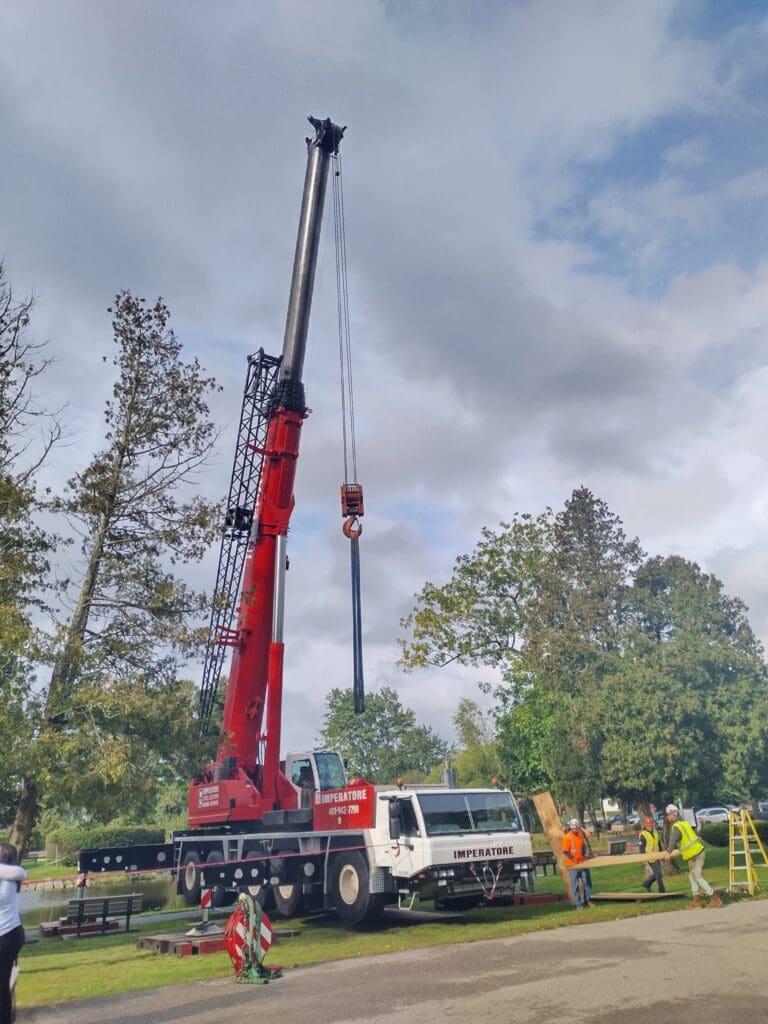
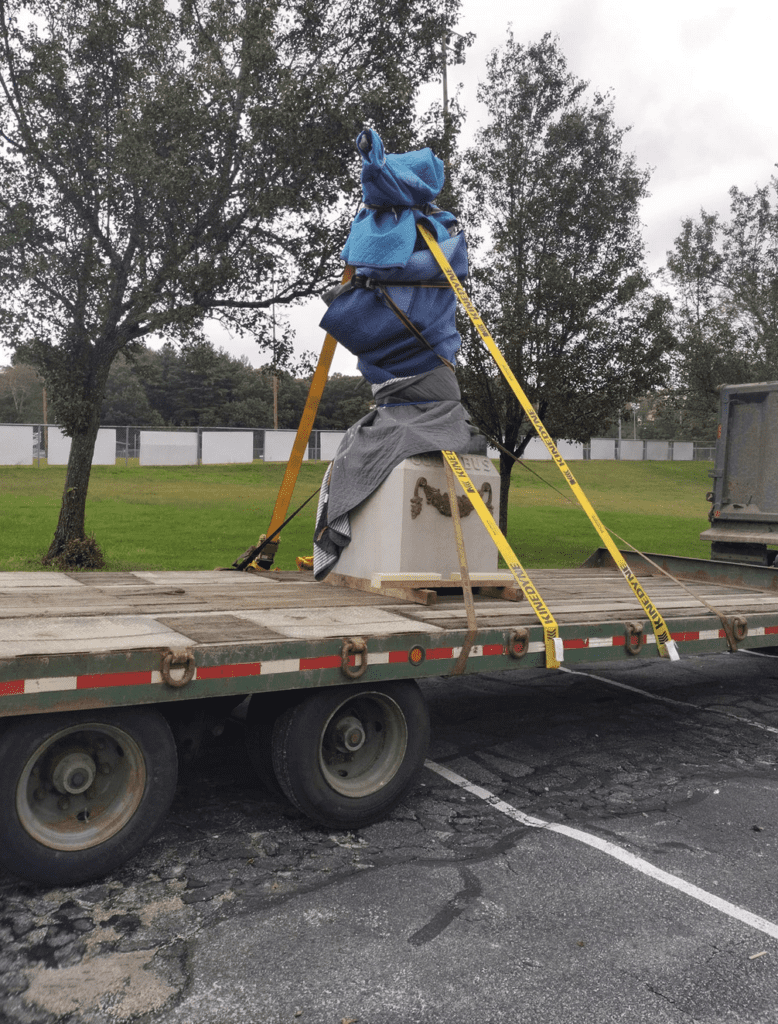
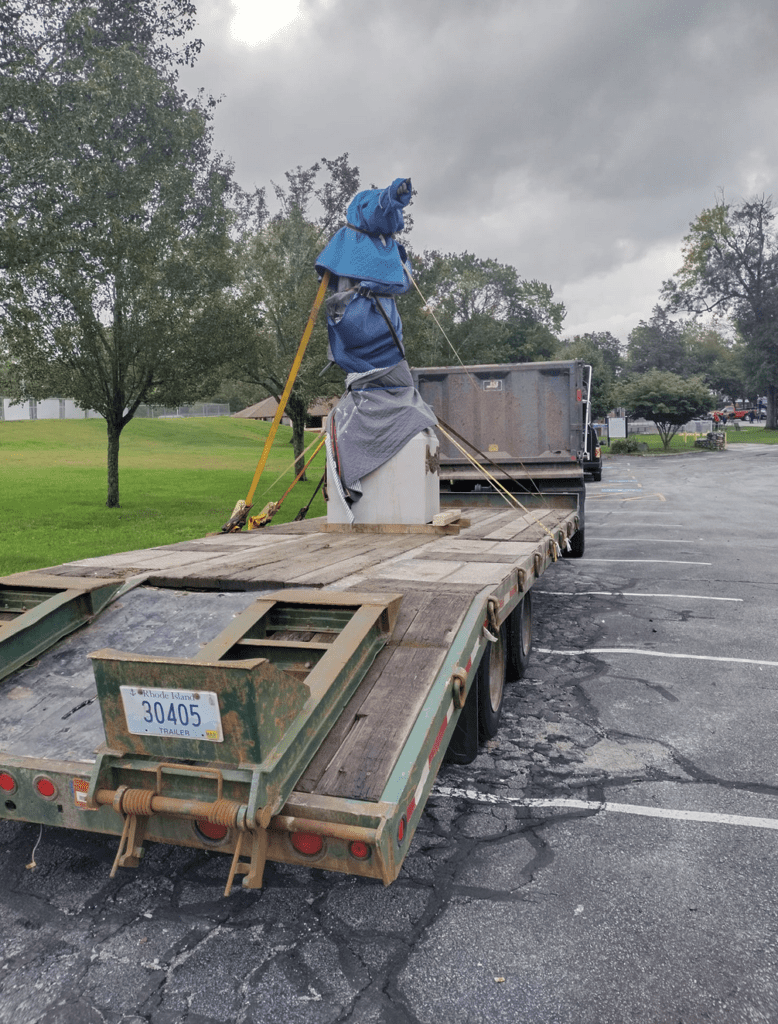

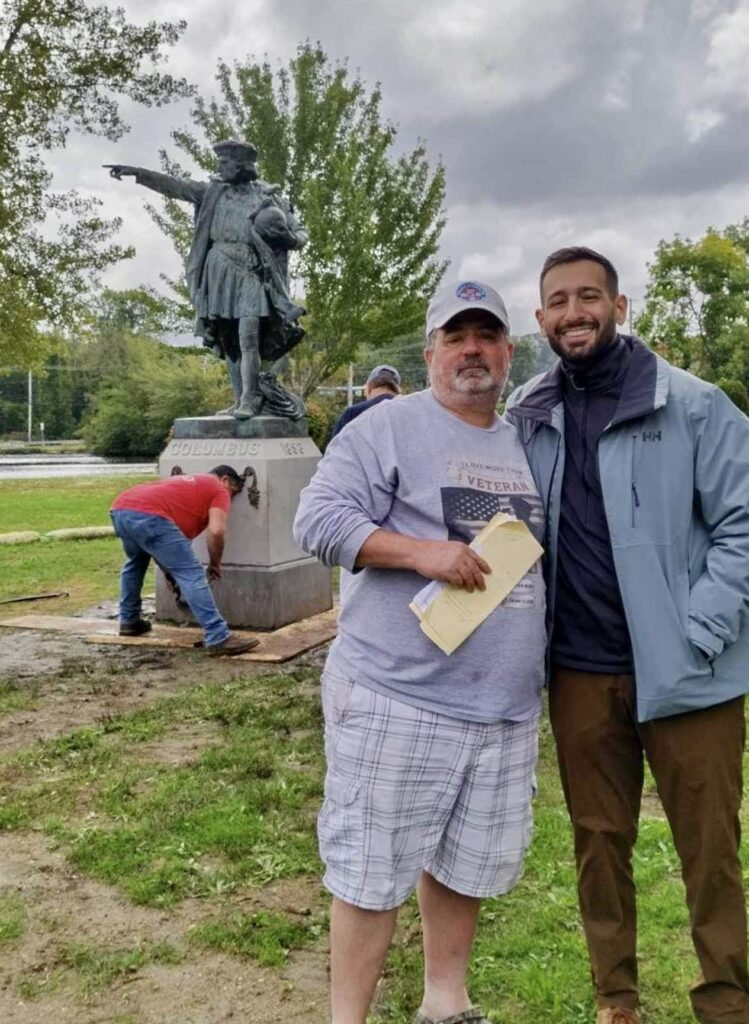
After the positioning took place on the prepared base and area, the statue was wrapped tightly with blue tarp, as it will stay until a planned First Annual Columbus Day Weekend event unveiling, is held on Monday, Oct. 9th. The island part of the park will be closed until that time for safety reasons.
Documenting the day’s activities was John A. Cianci, Veterans writer for RINewsToday.com. John is also a Veteran Service Officer, who is with the Italian American War Veterans, American Legion, Veterans of Foreign War, and the United Veterans Council of Rhode Island. He is an active volunteer assisting veterans to navigate federal and state benefits they have earned. He is Department of Rhode Island Department Commander Italian American War Veterans and Veteran Service Officer. Cianci’s veterans column, “RI Veterans: Did you know?” runs weekly, here, on Thursdays.
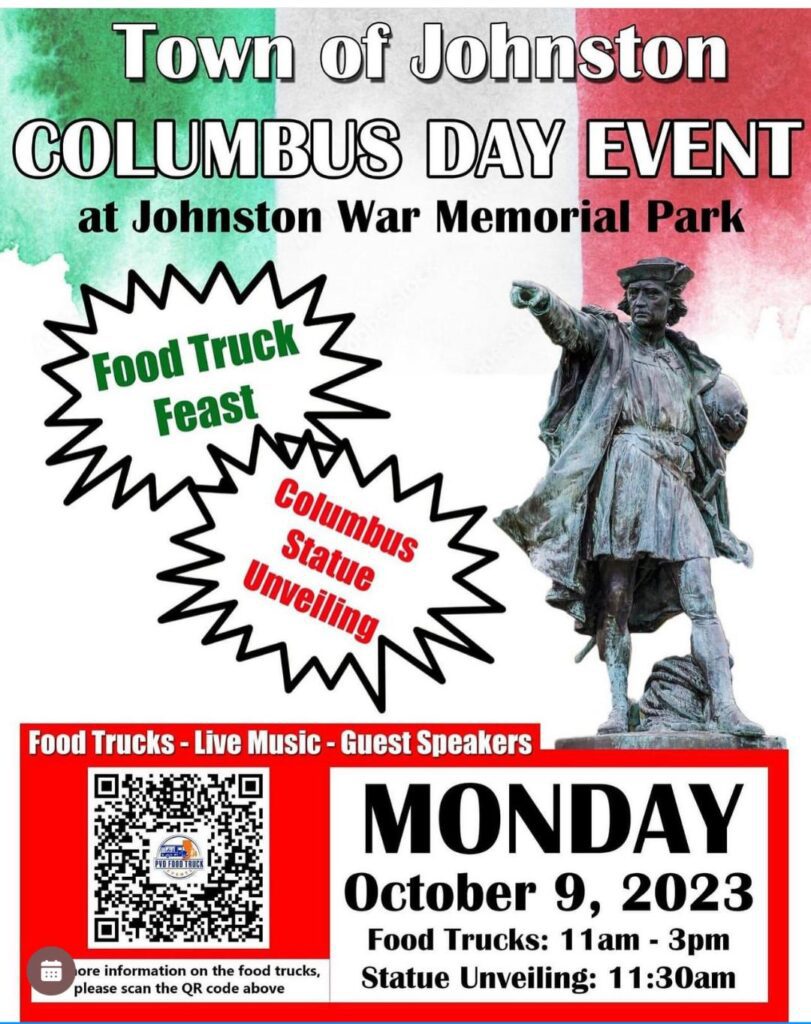
A Columbus Day welcome
With an official ceremony planned for Columbus Day weekend, yesterday’s “soft opening” was an opportunity to position him correctly, and make sure fencing, landscaping, and security, were worked on ahead of time for the big reveal. A family event with food trucks, live music, and special guest speakers will take place on Monday, Oct. 9th, from 11am to 3pm, with the unveiling set for 11:30am.
–
How do we talk about the Columbus statue with each other?
Times have changed from those powder keg moments a short time ago. Yet the issue of statues simmers in our memory and can flash up among people when the topic is brought up. Tolerance of Columbus statues, like other historical monuments, can be a complex issue. While some individuals, particularly the Italian community, advocate for their preservation, others argue for their removal or contextualization due to concerns about Christopher Columbus’ actions and their historical impact on indigenous peoples. One source gave us several reasons why people would consider tolerance in this debate:
- Historical Preservation: Columbus statues can serve as historical artifacts that reflect the time and context in which they were erected. Preserving them can be viewed as a way to maintain a record of past societal values and beliefs, even if those values have evolved.
- Educational Opportunity: Statues of Columbus can be used as educational tools to engage in conversations about history, colonization, and their consequences. They offer a platform for discussing the complexities of the past and present.
- Cultural Significance: For some communities, particularly the Italian community, Columbus statues hold cultural or sentimental value, representing a connection to their heritage or the historical contributions of their ancestors. Tolerance can be a way to respect and acknowledge these sentiments.
- Artistic Expression: Statues, as forms of art, often convey a range of emotions and perspectives. Appreciating them – as art – allows for open dialogue and diverse interpretations, enriching the cultural landscape.
- Contextualization: Rather than removal, some argue for contextualization of Columbus statues. Placing them in museums or adding informational plaques that provide a balanced historical account can help provide a more nuanced understanding of the figure and the events he represents.
- Focusing on Broader Issues: Some argue that the energy spent on debates over Columbus statues could be better directed toward addressing contemporary issues, such as social justice, inequality, and indigenous rights. Tolerance can shift the focus toward these pressing concerns.
- Promoting Dialogue: Promoting tolerance encourages open and respectful dialogue between different viewpoints. Engaging in conversations about the significance and impact of Columbus statues can lead to greater understanding and empathy among communities.
- Avoiding Erasure: Removing statues can sometimes be seen as an attempt to erase or rewrite history, which may not necessarily lead to a more accurate understanding of the past. Tolerance allows for a more comprehensive approach to addressing historical wrongs.
It’s important to note that the debate surrounding Columbus statues can be a deeply emotional one. The key is to engage in respectful and informed discussions, considering the perspectives of all stakeholders while striving for a balanced resolution that respects both history and the values of today’s society.
Engaging in a productive and respectful conversation with people who have negative views about Christopher Columbus can be challenging but can also lead to meaningful dialogue and understanding. Here are some strategies for addressing arguments from individuals who dislike Columbus:
- Listen Actively: Start by listening carefully to their arguments and concerns. Show that you respect their viewpoint and are open to understanding their perspective.
- Stay Calm and Respectful: Maintain a calm and respectful demeanor throughout the conversation. Avoid getting defensive or confrontational, as this can escalate tensions.
- Acknowledge Historical Criticisms: Recognize that there are valid historical criticisms of Columbus, such as his treatment of indigenous populations and European colonization. Acknowledge these concerns as legitimate historical issues.
- Seek Common Ground: Look for areas of agreement or common ground, such as acknowledging the suffering of indigenous peoples during colonization.
- Provide Historical Context: Offer historical context to provide a more nuanced understanding of Columbus and his era. Explain the prevailing attitudes and beliefs of the time, some of which would be considered unethical today.
- Highlight Positive Aspects: Mention some of Columbus’s positive contributions to history, such as his role in opening up transatlantic exploration and cultural exchange, to help balance the conversation.
- Discuss the Complexity of History: Emphasize that history is often complex and filled with both positive and negative aspects. Columbus, like many historical figures, had a multifaceted impact on the world.
- Propose Contextualization: Suggest the idea of contextualizing Columbus statues or monuments rather than outright removal. Explain how this approach can provide a more comprehensive understanding of history.
- Emphasize the Importance of Dialogue: Express the value of open dialogue and the opportunity to learn from different perspectives. Encourage ongoing conversations about historical figures and their legacies.
- Broader Issues: The conversation can turn to broader issues related to social justice, indigenous rights, or contemporary challenges. This can help the discussion become more relevant to actionable topics.
- Offer Additional Resources: Recommend books, documentaries, or other resources that provide a more comprehensive understanding of Columbus and the impact of European colonization.
- Agree to Disagree: Sometimes, it may be necessary to agree to disagree. When it becomes clear that parties will not change their stance, acknowledge that differing viewpoints exist and move on to other topics.
Why do people oppose the Christopher Columbus statue here and in other locations in the US?
The debate surrounding Christopher Columbus statues centers on the following points:
- Historical Perspective: Christopher Columbus is often credited with “discovering” the Americas in 1492. However, this viewpoint has been challenged because Indigenous peoples had inhabited the Americas for thousands of years before Columbus’s arrival. Critics argue that celebrating Columbus perpetuates a Eurocentric perspective that ignores the rich and diverse history of Indigenous cultures.
- Treatment of Indigenous Peoples: Columbus’s expeditions to the Americas led to the colonization of indigenous lands and the suffering of indigenous populations. His arrival brought about disease, violence, and enslavement, causing significant harm to native communities.
- Controversial Legacy: Columbus’s legacy is marred by controversies, including his role in the enslavement of Indigenous people and his role as a colonial administrator.
- Evolving Values: As societal values and perspectives change, many people believe in reevaluating who and what we choose to commemorate. This applies to many other statues other than Columbus throughout the world.
- Reconciliation and Education: Some argue that the Columbus statue issue can be a step towards reconciliation and a chance to educate the public about the complex history of long ago times, values and customs and today’s contemporary feelings.
The Columbus statue(s) controversy has waned over the last few years, begun at a time when many important issues inflamed the senses of just about everyone. Time will tell if we have matured, growing in respect for one another, and for traditions hundreds of years old.
Johnston, Rhode Island is the most Italian municipality in Rhode Island, and one of the most in the United States, with 46.7 percent of its population claiming Italian ancestry. Mayor Polisena has welcomed adding a statue from the Indigenous community at Johnston War Memorial Park.
___
Our last story about the Columbus statue move:

Excellent write-up and a great follow-up. I thank you for your attention to this public issue.